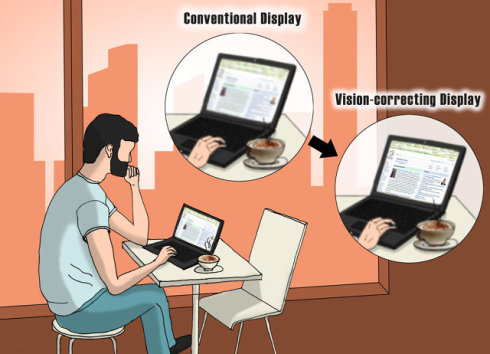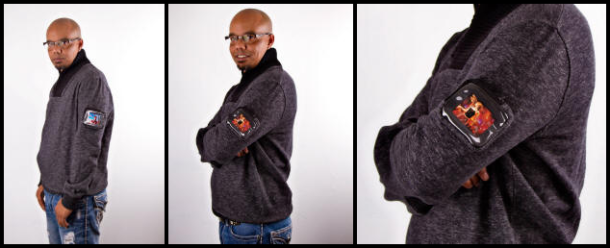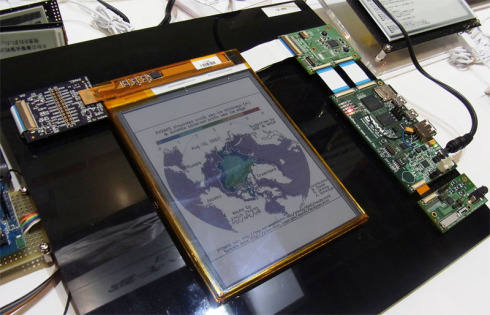Display Technology News Roundup 11.19.2015

Image via Ultrahaptics
Display Alliance is sponsored by Smarter Glass (www.smarterglass.com), a leading distributor and solutions provider with nearly 15 years specializing in the global LCD display industry and PCAP touchscreens. This blog is an open resource for the display industry and welcomes content and sponsorship from readers. Contact us to discuss how we can work together on Display Alliance. For display panels, visit the Smarter Glass display database to search and compare thousands of panels side-by-side.
Taking Touch-Based Display Interfaces to the Next Level "It is time to take touch-based interfaces to the next level, and a UK startup called Ultrahaptics proposes to do just that by providing multi-point, mid-air, haptic feedback. The company has developed a novel approach using an old technology, promising to overcome the limitations found in current touch-based systems and open the door for a fundamental shift in the way people interact with electronic devices. ...In the medical arena, the incorporation of touch-based interfaces in systems presents its own hurdles. While touchscreens provide a fast and efficient way to interact with healthcare equipment, they also pose hygiene risks arising from the very physical contact that makes the interface so effective. What all these applications require is touch without touch. To meet this unique demand, developers have turned to 2-D arrays of ultrasound transducers, or emitters, to create haptic feedback systems. The arrays create airwaves that stimulate neuroreceptors in the skin, allowing users to feel sensations on their hands. By modulating the output of the emitters, a system can induce a variety of tactile sensations. However, implementing this approach comes with a fair share of difficulties." via IHS Electronics360
4-D laser printing: holograms and beyond ""Not long after we received the NSF funding, we were able to create something called the direct-write laser scanner (DWLS), which allows us to create nearly perfect geometric phase holograms," says Escuti, an engineer at North Carolina State University. "They look like flat, semi-translucent plates, but they give us unprecedented control over the behavior of light. We can use them to make more efficient displays for mobile devices, sensors with greater resolution, and, frankly, we're still discovering all of the potential applications for this technology." To make geometric phase holograms, the DWLS "prints" using an ultraviolet laser on a super-thin film--only about 50 nanometers thick. The film is made of a photoreactive polymer that responds to both the intensity and the polarization of the light. When the DWLS is done printing, a much thicker layer of liquid crystal is applied, amplifying the pattern on the underlying thin film. To understand how the DWLS works, you have to understand that it doesn't have an inkjet--it prints light, and it prints in four dimensions." via National Science Foundation
How LED display technology creates this dazzling, data-driven chandelier "Soaring 33 stories above downtown Pittsburgh and built to use half the energy consumed by typical office buildings, this LEED Platinum-exceeding glass and steel edifice, complete with double-skin façade and solar chimney, has been heralded as the greenest skyscraper ever completed. (Seattle’s six-story Bullitt Center still likely rules when it comes to green commercial buildings.) And as for the Tower at PNC Plaza's main lobby, it's one high-rise lobby that can never, ever be accused of being soulless. ...And, as PNC explains, the installation itself is, go figure, super-efficient: Each panel has liquid crystal film that becomes clear when it receives electricity, or opaque without it. Inside is a grid of 8 LEDs that show a range of colors. These elements can be used simultaneously or separately to create animations with a variety of color, motion, and diffusion. The liquid crystal film draws no energy when opaque and uses very little when transparent, while LEDs use less energy than incandescents, making the Beacon highly energy-efficient." via Mother Nature Network
Can China's LCD Panel Industry Dominate By 2018? "It is being predicted that China will become the world leader in LCD panels in 2018 by beating Korea, as the nation began to make massive investments in LCD panels used in smartphones and flat TVs. Japan’s Nippon Keizai Newspaper reported that China’s four leading display companies, such as the BOE Technology Group, will build seven big factories in China with investments of about US$25 billion for three years. According to the newspaper, the investment volume is very large compared to the fact that Samsung Electronics invests US$3.5 to 4 billion in the LCD business a year. Chinese companies with strong financial support from the Chinese government will lift China over Taiwan in 2017 and Korea in 2018 in terms of the volume of LCD panel production, the newspaper expected. It is said that despite an economic slowdown, China began such massive investments as it intends to escape from the market structure where China depends on Korea and Taiwan for 70 percent of its demand for LCD panels. It is expected that this move by China will give Korean companies two troubles – a drop in exports to China and a price war triggered by an increase in LCD panel supplies by China." via BusinessKorea
Display database for engineers Search thousands of display panels by multiple characteristics and compare results side-by-side using the display database multisearch.
In Search of the Perfect Pixel: What Are the New Developments in LCD Panels? "Another development that we do not readily see immediately is the inclusion of Simple Network Management Protocol (SNMP) in displays. It is an Internet-standard protocol for managing devices on IP networks. Historically, we have had devices that typically support SNMP, including routers, switches, servers, workstations, printers, modem racks– and now finally displays, as LG showed at InfoComm 2015. SNMP is widely used in network management systems to monitor network-attached devices for conditions that warrant administrative attention. Having this available on large scale displays is a great addition, but one that may be overlooked. Consider the ability to monitor and manage the health of multiple displays across an office complex using standard tools the IT department already has. Also, think about the implications for digital signage applications. One last development that we see gaining traction is System on a Chip or SoC for short. Samsung did most of the pioneering work on this and now has been followed by others. The SoC is a mini computer built into the display in the form of a chip. It can act as a media player for digital signage or perform other computer-based tasks but it eliminates the need for external devices in many cases. Some of these, like the units developed by Samsung run proprietary software, but we are seeing more “open” platforms, like the WebOS SoCs offered by LG, and the Android powered devices offered by BenQ." via AVNetwork
What is "technorating" with digital signage? "Back in 2008, LG Electronics coined the term "techorating" for that latter one, a fusion of technology and decorating, using tech to create or be an element of interior design and decor. At the time, LG was focused more on the consumer- or residential-grade market, even enlisting the help of celebrity interior designer Doug Wilson of TLC's "Trading Spaces" as the first official "Techorator" to develop consumer tips and tricks to guide consumers through the techorating process. Since then, LG and all the digital signage display manufacturers from Christie to NEC to Samsung have explored ways their professional- or commercial-grade displays or projectors could be used in a kind of digital signage techorating for professional spaces and businesses, whether it's in a corporate or hotel lobby, restaurant dining room or even a museum. Display provider Planar Systems Inc. helped lead the charge in the commercial space, with its Mosaic system that allowed its displays to be hung in artistic or unusual configurations for video walls that broke out of the square or rectangular box on the wall. But the trend has moved beyond any one company or even any one industry, as the Society for Experiential Graphic Designers and other professional groups representing architects, interior architects, interior designers and interior decorators have started to take a longer look at including display technology in their plans, sometimes even before a single brick is laid." via Digital Signage Today
All-inorganic perovskite quantum dot display breaks Cd-barrier "Ever since the first cadmium selenide (CdSe) QD-based light-emitting devices (QLEDs) were reported in 1994, the dominant materials for QLEDs investigated since then have been limited to wurtzite or zinc blende Cd-based QDs. Similarly, the best developed and studied colloidal QD lasers have been fabricated from Cd-based semiconductors. Now, researchers have presented a new family of photoelectric materials for light-emitting devices: colloidal all-inorganic perovskite cesium lead halide QDs. This new material could find applications in LEDs and lasers, and has an especially big potential in high-performance displays, lighting, monochromatic narrow-band photodetectors, and optical communications." via Nanowerk
Bright Blue PHOLEDs Almost Ready for TV "Phosphorescent OLEDs (PHOLEDs) use only one quarter the energy of conventional OLEDs. Green and red PHOLEDs are already used in smartphones and TVs, leading to longer battery lives and lower electricity bills, but developing the kind of bright deep blue PHOLEDs needed for video displays has proven challenging. Now scientists have developed what they say are the brightest deep blue PHOLEDs reported so far, work sponsored by Universal Display Corporation and the U.S. Air Force. The researchers added their new lights nearly meet the most stringent requirements of the National Television Systems Committee (NTSC), the video standards used across most of the Americas. "There have been previous works that reported PHOLEDs having similar color as ours, but their brightnesses were very dim, about 10 times less," says study lead author Jaesang Lee, an electrical engineer at the University of Michigan, Ann Arbor. "A combination of high brightness and deep blue color is quite revolutionary."" via IEEE Spectrum
Do you have content to share with Display Alliance? Anyone can post press releases, white papers, commentary, videos, and more in the open section.
Can Projectors Compete with Flat Panel Displays? ““Typically projectors are more flexible than flat screen displays because the size of the image projected can be adjusted to meet the needs of the customer and tailored to specific applications,” adds Damien Weissenburger, head of corporate and education solutions at Sony Professional Solutions Europe. “For large rooms which require large screens – more than 75in – or a more flexible format – that is, something other than 16:9 – projection remains the main technology. Projectors often provide a more affordable and flexible solution which can appeal to budget-conscious AV managers.” Versatility, affordability, ease of installation are all contributing to projection’s longevity – even as flatpanel displays are getting larger and, in theory, displacing what would previously have been projection installations. But projectors have an important advantage here too." via Installation
Will touchscreens be replaced by eye-tracking display technology? "Eyefluence, a company that has created a unique eye tracking system for use with today’s virtual reality/augmented reality headsets, emerged from stealth today with a $14 million Series B funding round. “Eyefluence transforms intent into action through your eyes. We believe anything you can do with your finger on a smartphone, you should be able to do with your eyes on a head-mounted display — only faster,” Eyefluence CEO Jim Marggraff told TechCrunch. While Eyefluence isn’t the first eye-controlled operating tool, it claims to be the first one to interpret intent with your eyes in real time. With eye controllers I’ve seen in the past, you need to stare to show intent, Eyefluence wanted to change this to a glance." via TechCrunch
How can large touchscreens be like your smartphone? "The Business Research Company’s report “Touch Screen Market Globally 2015” finds that since 2009, it is projected -capacitive (P-CAP) technology which has captured the highest-volume touch categories of mobile phones. This success has been driven by a feature set which includes an effectively unlimited lifespan conferred by a resistant all-glass surface, edge-to-edge design capability (with no requirement for bezels) and high levels of sensitivity. PCAP manufacturers are now taking this technology to screens as large as 85 inches. Four important aspects of the screen design are: speed, accuracy, EMI immunity and integration. Where consumer phones have to register just one or two touches on a screen of around 4.5-inch diagonal, commercial touch screens of 47-inch diagonal that can register between 10 and 40 touches with a precision of 1mm are now commonplace. The area of a 16:9 format screen roughly quadruples when the diagonal doubles." via ElectronicsWeekly
Automative Touchscreen Buttons You Can Actually Feel "Bosch has come up with an experimental solution to our touchscreen woes: A screen with simulated "buttons" that you can navigate by feel, without taking your eyes off the road. Haptic elements in the screen allow users to distinguish different "keys" on the touchscreen by feel—rough, smooth, and patterned surfaces can be created to denote individual keys or functions. "The keys displayed on the touch screen have the feel of realistic buttons so that it is often possible for users to find their way around the keyboard without looking while operating the applications," Bosch says. "They can keep their eyes on the road for much longer periods, substantially enhancing safety while driving"" via Road and Track
Are you an engineer or have display expertise? Contact us to be featured in the interviews section.
How Can a Touchscreen Know the Angle of Your Finger? "A Carnegie Mellon University spinoff called Qeexo might have just one-upped the iPhone 6s and 6s Plus’s 3D Touch capabilities—and instead of buying a new phone for the new feature, you’d just need to upgrade it.The researchers behind FingerAngle developed a brand new algorithm that allows a smartphone to estimate the pose of a finger, in 3D, as it makes contact with a touchscreen. This includes its angle relative to the display, as well as any rotation of the finger while it’s making contact. It’s subtle, but the shape of a fingertip while pressed against a glass display is very distinct based on what part of the finger is making contact, and its angle. And this is what the researchers rely on to determine a finger’s orientation relative to a touchscreen. So why is this useful? To do on-screen rotations with a touchscreen currently requires the use of two moving fingers. But the tiny display on a device like a smartwatch barely has enough room for a single digit. (Video)" via Gizmodo
'BitDrones' Offer 3D Computer Displays Based on Programmable Matter "How's this for a bad-ass future? "Interactive self-levitating programmable matter." This is how researchers at Queens University's Human Media Lab are describing their new virtual reality scheme, dubbed BitDrones, set to be unveiled Monday at the ACM Symposium on User Interface Software and Technology in Charlotte, North Carolina. The floating interface is enabled by swarms of nano quadcopters (the drones of BitDrones), of which there are three varieties. "PixelDrones" come equipped with a single LED and a small dot-matrix display; "ShapeDrones," which are intended to form the building blocks of 3D models, come covered in a fine mesh and a 3D printed geometric frame; and, finally, "DisplayDrones" are fitted with a curved flexible high-resolution touchscreen, a forward-facing video camera, and an Android smartphone board. All three varieties then come equipped with reflective markers, allowing them to be tracked in real-time using motion capture technology. (Video)" via Motherboard
Planar Introduces Transparent OLED Digital Signage "Reminiscent of those products dreamt up by science fiction filmmakers – where video content seems to float on an almost-translucent display – the Planar LookThru OLED transparent display uses OLED technology to eliminate the need for a backlight or enclosure. According to Planar, transparent OLED technology overcomes one of the main hurdles to transparent LCD display adoption by making it possible to create truly see-through installations unobstructed by enclosures that sit behind the displays. The LookThru OLED transparent display allows users to view video content, digital images and text on a virtually frameless glass display while enabling designers to overlay this content onto real objects or scenes that sit behind the glass. The company first showcased a transparent OLED technology display demonstrator at the Integrated Systems Europe event in February." via Government Video
Wearable Mini-Display Helps Medical Doctors Save Patient Lives "Opting for a minimalist, hands-free approach, user-experience design firm Method, in collaboration with Bay Innovation, have designed a new HUD (Heads-up Display) named Vivi that instantly delivers patient vitals and supplementary materials to doctors mid-operation. Most notable for its simplicity, the wearable pops over one eye when operating and subsequently swivels out of the way when not needed, making for a practical-use case that’s as serviceable as it is modest. Peering into the device, surgeons are presented with a diminutive 8-bit-esque display configurable through their smartphones." via psfk
Apple’s 3D Touch displays on the iPhone 6S or 6S Plus can be used to weigh objects "In a playfully written blog post, Simon Gladman talks about his newest app, which is called the Plum-O-Meter. As its name implies, the app leverages the 3D Touch technology in his iPhone 6S to act as a scale of sorts that tells the user which of the objects placed on the smartphone’s screen is heavier. ...Technically, the iPhone’s multitouch display can simultaneously sense up to five objects at a time, iDownloadBlog points out. "I did originally build this app for grapes, but they’re too light to activate the 3D Touch," Gladman writes in his blog post. (Video)" via Digital Trends
Folium Optics brings plastic displays to medical and defense markets "Folium Optics was founded two years ago by Kitson and John Rudin, after both had worked on display solutions at Hewlett Packard's HP Labs Bristol research center. When HP's goals shifted, the pair set up Folium to pursue flexible displays, and rather than basing their efforts on any existing HP technology, chose to begin with a clean sheet - "applications-driven and technology-agnostic," commented Kitson. ..."We use a similar materials set to a conventional LCD, but dope it with dye molecules. These molecules are rod-shaped and designed to orientate themselves with the liquid crystals under an applied voltage. When the liquid crystals rotate, the dye molecules rotate too." Controlling the profile that the dye molecules present to an observer also controls the strength of color perceived by that observer, and does so without the need for the polarizers or related technology which can contribute to the cost and complexity of other LCD systems. "This principle is called a guest-host LCD and has been known for some years, although it went out of favor as interest focused on backlit displays," noted Kitson. "It has been a little neglected; so we are revitalizing it, improving the materials and combining them with flexible plastics."" via Optics.org
Why Display Manufacturers Need A Hand "While we see some companies capitulate during crystal cycle busts (asset impairments/sales by CPT is a recent example) we have not seen mergers on the scale of AUO buying Innolux or AB InBev buying SAB Miller. Lack of scale economies is one reason for this, perhaps. As I have presented at SID conferences, adding AMLCD area capacity does not seem to reduce AMLCD area cost. A big merger might lead to a swanky party but the hangover would certainly lead to a long-term headache trying to load the increased capacity with profitable product. If there is no advantage to consolidation, we may see the AMLCD industry continue to evolve along national lines of interest. China is doing what it did in LED and PV industries and it hopes to do in the IC industry: cultivate national champions and capture global share. If this is the future, what can we do but give display makers a hand?" via Display Daily
What did you think about today's news? Leave a comment here and share your thoughts.
 News Roundup tagged
News Roundup tagged  3D,
3D,  Automotive,
Automotive,  China,
China,  Digital signage,
Digital signage,  LCD,
LCD,  LED,
LED,  OLED,
OLED,  PHOLED,
PHOLED,  Pixels,
Pixels,  Projected capacitive,
Projected capacitive,  Projector,
Projector,  Touchscreen
Touchscreen 








